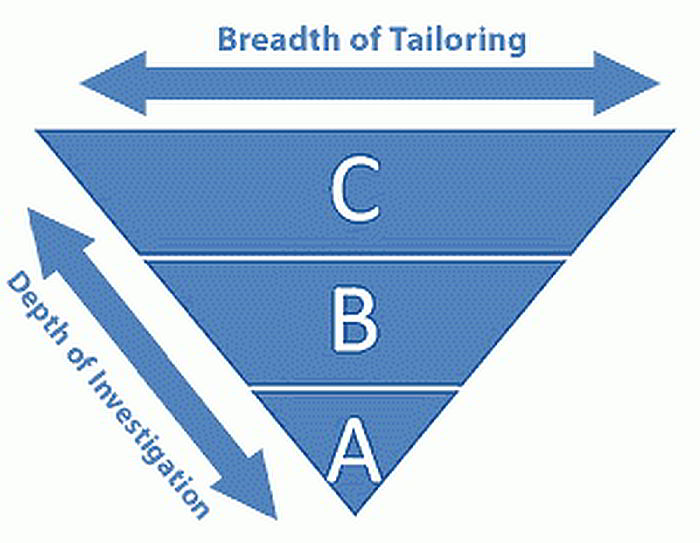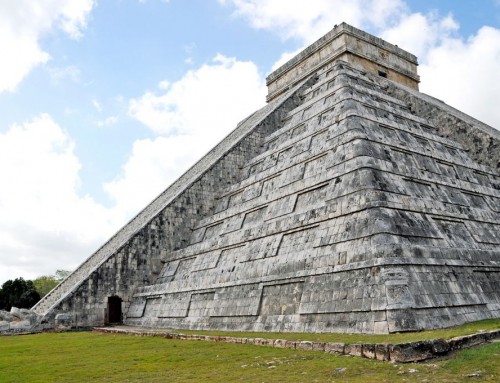Standard CMMI Appraisal Method for Process Improvement
SCAMPI Appraisal Classes
The Capability Maturity Model Integration is a process framework to develop, optimise, and assess organisational processes.The Standard CMMI Appraisal Method for Process Improvement (SCAMPI) is designed to provide benchmark quality ratings relative to Capability Maturity Model Integration models. It is applicable to a wide range of appraisal usage modes, including both internal process improvement and external capability determinations.
SCAMPI satisfies all of the Appraisal Requirements for CMMI requirements (ARC) for a Class A appraisal method and supports the conduct of ISO/IEC 15504 assessments as well.
The SCAMPI family of appraisals includes Class A, B, and C appraisal methods.
- SCAMPI A is the most rigorous method and the only method that can result in a rating.
- SCAMPI B provides options in model scope, but the characterization of practices is fixed to one scale and is performed on implemented practices.
- SCAMPI C provides a wide range of options, including characterization of planned approaches to process implementation according to a scale defined by the user.
Using SCAMPI B, every practice in the appraisal scope is characterized on a three point scale indicating the risk of CMMI goal satisfaction if the observed practices were deployed across the organisational unit. Model scope is not limited to the Process Areas but could include sets of related practices.
SCAMPI C can be scoped at any level of granularity and the scale can be tailored to the appraisal objectives, which might include the fidelity of observed practices to model/goal achievement or the return on investment to the organisation from implementing practices.
Reliability, rigor, and costs might go down from A to B to C, but risk might go up.
SCAMPI Class A
A SCAMPI Class A appraisal, the most rigorous of the Software Engineering Institute (SEI) process appraisal methods, is typically conducted when an organisation has implemented a planned set of process improvements and needs to formally benchmark its process relative to the CMMI.
A SCAMPI A is the only appraisal method that provides a recognized CMMI maturity level rating.
A SCAMPI A appraisal is typically conducted when an organisation has implemented a number of significant process improvements and needs to formally benchmark its process relative to the CMMI. A SCAMPI A is the only appraisal method that provides CMMI maturity level or Capability Level ratings.
Class A methods must satisfy all of the Appraisal Requirements for CMMI (ARC) requirements, and at the present time are the only methods considered suitable for providing ratings for benchmarking. Developers of Class A methods also have the option of supporting the conduct of 15504-conformant appraisals. An example of a Class A method is the Standard CMMI Appraisal Method for Process Improvement (SCAMPI).
What can you expect from a SCAMPI A?
- A maturity level rating or Capability Level ratings
- Findings that describe the strengths and weaknesses of your organisation's process relative to the CMMI
- Consensus regarding the organisation's key process issues
- An appraisal database that the organisation can continue to use to monitor process improvement progress and to support future appraisals.
SCAMPI Class B
A SCAMPI Class B appraisal, one of three SEI appraisal methods, helps an organisation understand, with a relatively high degree of confidence, the status of its software and systems engineering process relative to the CMMI. A SCAMPI B is often performed when an organisation needs to accurately assess its progress towards a target CMMI maturity level.
A SCAMPI B is called for when an organisation needs to assess its progress towards a target CMMI maturity level, but at a lower costs than a SCAMPI A. SCAMPI B appraisals provide detailed findings and indicate the likelihood that the evaluated practices would be rated as satisfactorily implemented in a SCAMPI A appraisal.
What can you expect from a SCAMPI B?
- Detailed findings that describe the strengths and weaknesses of your organisation's process relative to the CMMI.
- Practice characterizations indicating the likelihood that the examined practices would satisfy the goals and meet the intent of the CMMI.
- Consensus regarding the organisation's key process issues
- A FIDO Database that the organisation can continue to use to monitor process improvement progress and to support future appraisals.
The SCAMPI B method is based on the. The main differences include:
- Appraisal teams can be smaller in size — only two people (including the Lead Appraiser) are required
- SCAMPI B requires less data, which reduces the number of artifacts that must be identified and organized before the appraisal and reduces the time and effort needed to conduct the appraisal
- A different scale for characterizing practice implementation is used
- No goal or process area ratings are provided
SCAMPI Class C
SCAMPI Class C appraisals, the least formal of the SEI's suite of appraisal methods, are highly flexible and can be conducted to address a variety of needs. Typically much shorter in duration than SCAMPI A and SCAMPI B.
SCAMPI C appraisals are often performed for reasons such as:
- a quick gap analysis of an organisation's process relative to the CMMI
- the adequacy of a new process before it is implemented
- the implementation of a process
- an organisation's readiness for a SCAMPI A
- the selection of a supplier
SCAMPI C appraisals are shorter and more flexible than SCAMPI A and SCAMPI B and are conducted to address a variety of special needs, from a quick gap analysis to determining an organisation's readiness for a SCAMPI A.
What can you expect from a SCAMPI C?
Because there is wide latitude in structuring a SCAMPI C, the types of results vary widely. Results reflect the purpose of the appraisal and often incude:
- that describe the strengths and weaknesses of the assessed processes. Depending on the appraisal scope and strategy, findings may be mapped to the relevant CMMI components.
- that summarize the adequacy of the assessed processes vis-á -vis the CMMI.
- process improvement actions.
- A FIDO Database that the organisation can continue to use to monitor process improvement progress and to support future appraisals.
Like a SCAMPI B, the SCAMPI C method is derived from the SCAMPI A. Significant differences between a SCAMPI C and a SCAMPI B include:
- A SCAMPI C can be scoped at any level of the CMMI structure, such as Process Area, goal, or practice.
- Appraisal teams can be as small as one person (i.e., Lead Appraiser only)
- Data corroboration and findings validation are not required (although may be advisable in some cases).
- There are no specific requirements regarding the sources of objective evidence (i.e., artifacts and interviews).
- A different scale is used for characterizing the examined CMMI components.
Baseline Assessment
When there is a need to establish an initial process baseline — typically, when an organisation has a low maturity process or is initiating a process improvement program — a Baseline Assessment is often the most cost-effective approach. Baseline Assessments characterize a process relative to the CMMI and provide a sound foundation for process improvement planning.
Characteristics of Appraisal Classes
| Characteristic | Class A | Class B | Class C |
| Amount of objective evidence | High | Medium | Low |
| Ratings generated | Yes | No | No |
| Resource needs | High | Medium | Low |
| Team size | Large | Medium | Small |
Further Readings
- Dennis M. Ahern, Jim Armstrong, Aaron Clouse:
(SEI Series in Software Engineering). Addison-Wesley Longman, Amsterdam, 2005.
- Marilyn Bush, Donna Dunaway:
. (SEI Series in Software Engineering). Addison-Wesley Longman, Amsterdam, 2005.








Leave A Comment